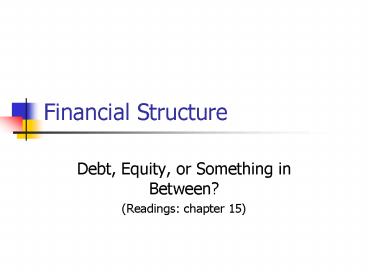Financial Structure - PowerPoint PPT Presentation
1 / 17
Title: Financial Structure
1
Financial Structure
- Debt, Equity, or Something in Between?
- (Readings chapter 15)
2
Some Financial Facts
- Firms prefer to finance with
- Retained Earnings
- Debt
- Hybrid Securities (Convertible Bonds)
- Equity
- This is known as Pecking Order of financial
sources
3
More Financial Facts
- Capital Structures (Debt-Equity Mix) vary
considerably across industries. - High growth companies (pharmaceuticals, software)
have little debt, or use convertible bonds - Cash Cows have considerable debt
- Highly profitable companies in each industry
could easily borrow much more than they do (e.g.
Microsoft, Amgen, Intel,)
4
Financial Facts continued
- Small Firms prefer short-term debt and debt
hybrids - Increases in leverage are viewed positively by
investors (and vice versa) - Corporate Bonds are complex contracts. They
typically contain covenants that restrict issue
of more debt and sometimes other restrictions
5
Overview Does Debt Matter?
- This chapter proceeds as follows
- We will see that in a simple world, the
debt-equity decision does not matter
(Modigliani-Miller Theorem) - But we know from reality that it does!
- So it must be factors outside the simplistic
model that drive corporate financing decisions.
6
The Modigliani-Miller Theorem
- The value of a firm is independent of how it is
financed if - The firms total after-tax cash flows are
independent of how it is financed - There are no transaction costs
- Note that this ignores tax differences,
bankruptcy costs, agency problems, and the like
7
Proof by Example
- Elco Corp. has 1,000 shares outstanding at 100 a
share. It also has 1-year zero-coupon debt
outstanding with a market value of 10,000 - Elco is considering to increase its leverage
- For this purpose, it plans to issue 50,000 of
debt in order to repurchase 500 shares at 100 a
piece.
8
An Elco shareholder is not affected by this
change
- Let X denote the random cash flow of Elco. Prior
to the change, an investor owning 100 shares
would receive - After the change, the investor would receive (he
now owns 20 of the company)
9
An Elco shareholder is not affected by this
change (ctd.)
- Suppose he sells 50 of his shares and uses the
proceeds to buy 5,000 of the firms bonds. His
payoff will be - Which is exactly as before.
- This example can be extended to include potential
bankruptcies
10
Intuition
- Financial Policy cannot create value because
shareholders can lever or unlever equally well
themselves - To create value, managers have to do things that
investors cannot do themselves, i.e. increase
cash flows - The most important way debt creates value is due
to the tax benefits of debt
11
Debt and Taxes The two Certainties of Corporate
Life
- Modigliani-Miller ignores the impact of corporate
taxes - Interest payments are tax deductible at the
corporate level - If the company faces a tax rate of tC, then every
dollar of interest payments only cost 1-tC - These tax savings are called the debt tax
shield
12
WACC with Taxes
- In chapter 12, we discussed the weighted average
cost of capital in the absence of taxes - Now, we should include the debt tax savings
- Typically, WACC refers to the 2nd case
13
1980s Leveraged Buy-Outs
- In the 1980s, many takeovers created value by
issuing more debt to save on taxes - In theory, the firm should issue infinite debt to
eliminate all tax liabilities - In reality, the firm can only issue a limited
amount of debt (debt capacity) - Also, we only save on taxes if the company is
profitable
14
1980s Leveraged Buy-Outs
- So what companies really benefit from the debt
tax shield? - Companies that are highly profitable
- Companies that do not need to retain earnings for
future growth - Companies that have many assets that are suitable
as collateral
15
1980s Leveraged Buy-OutsExample RJR Nabisco
- A prime example is RJR Nabisco (RJR tobacco,
Nabisco food) - In 1987, RJR Nabisco earned 2,304m before
interest and taxes. - It paid 735m in taxes and 488m in interest (tax
rate tC40.5) - What if the company chose to distribute 5b in
9.4 bonds to shareholders? These bonds require
470m interest
16
1980s Leveraged Buy-OutsExample RJR Nabisco
CF increases by 2.64-1.88 0.76 a share
17
RJR Nabisco
- We will revisit that company soon and see how the
calculation above tempted Kohlberg, Kravis,
Roberts (KKR) to buy the company and create value
by issuing an enormous amount of debt. - Many companies nowadays have near-optimal capital
structures - Exception Some companies like Microsoft, Intel,
Amgen, could easily have much more debt than they
do































